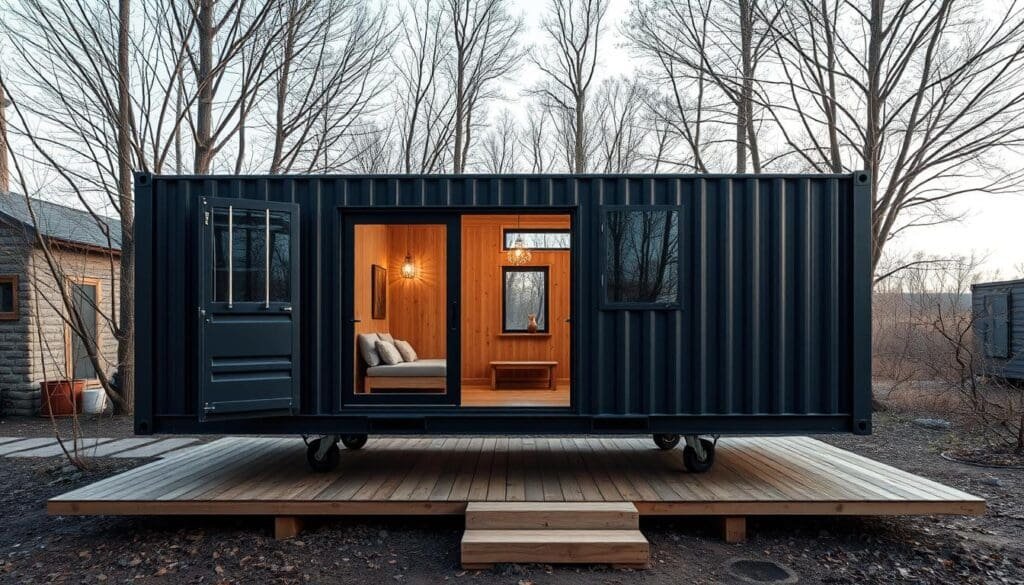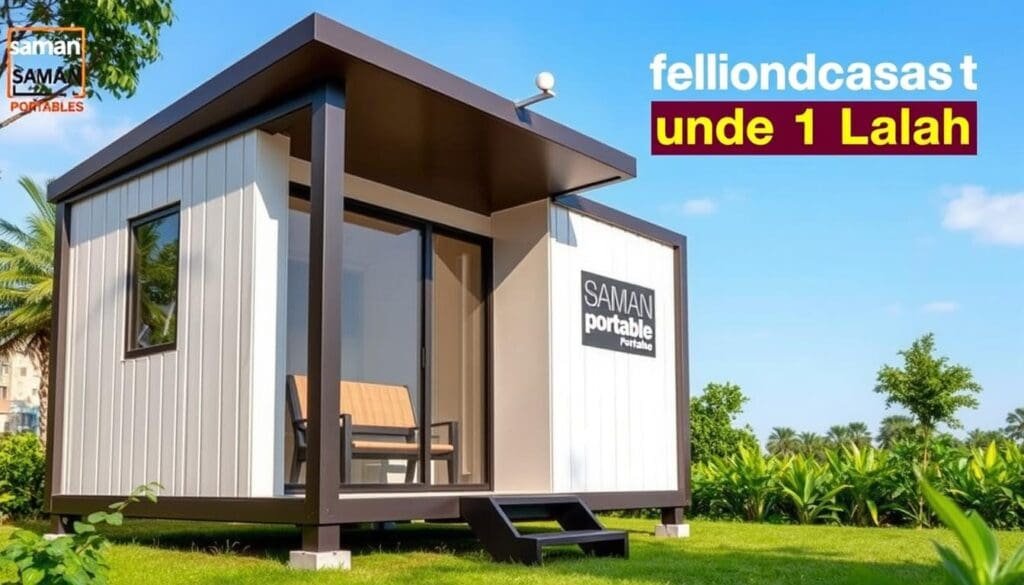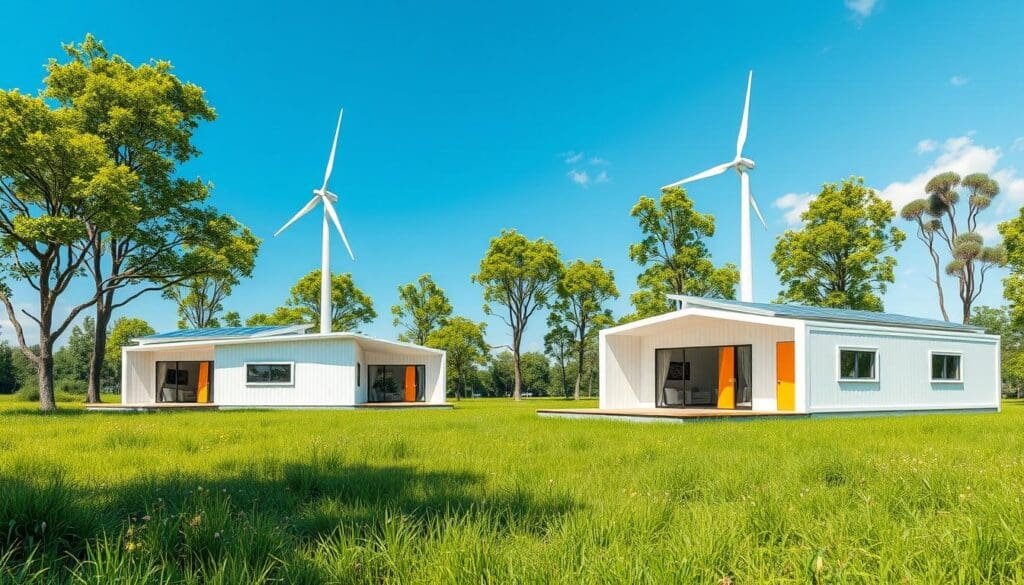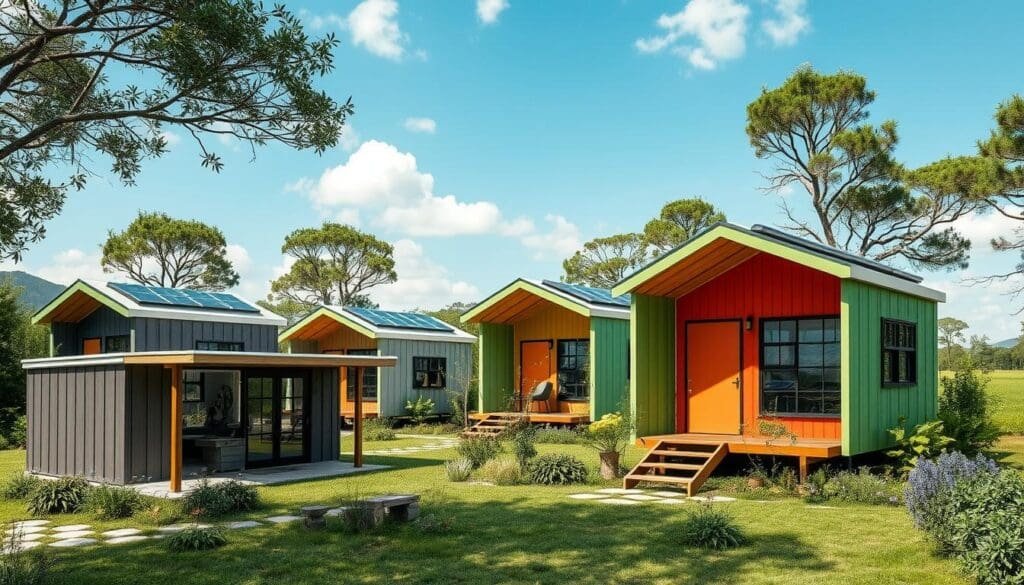Container House in India: Redefining Modern Living and Affordable Housing Solutions
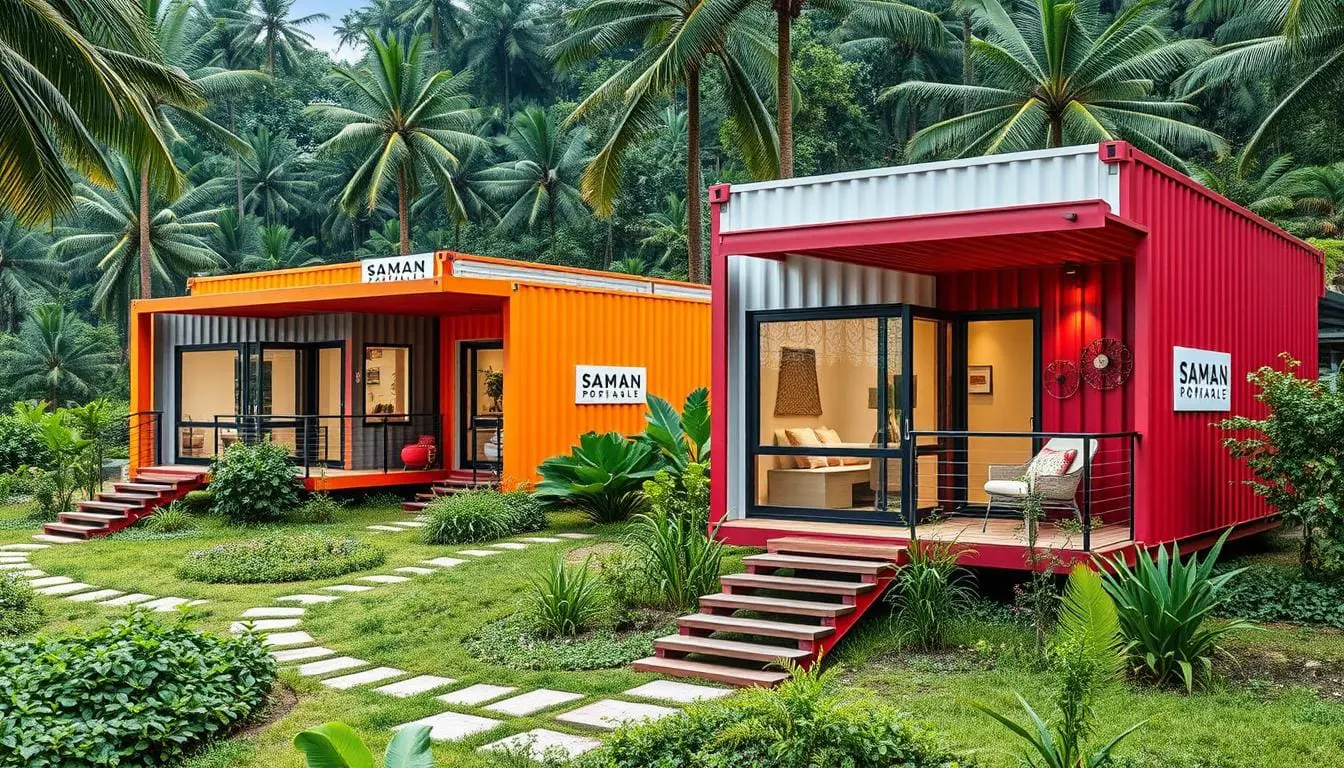
In India, a big housing shortage and the need for green living have led to a new solution: container houses. These homes are made from old shipping containers. They are changing how we think about modern living and affordable homes.
So, why are container houses so interesting? And how do they help solve big problems for homeowners and builders? Let’s explore the exciting world of container architecture and see why it’s becoming popular in India.
Key Takeaways
- Container houses offer a sustainable and eco-friendly solution by repurposing shipping containers, reducing waste and promoting recycling.
- Affordability is a significant advantage, with container homes typically costing less than traditional homes due to reduced construction expenses.
- The construction process for container houses is generally faster than conventional building methods, as the basic structure is already in place.
- Flexibility in design and customization allows container houses to cater to a wide range of individual preferences and living requirements.
- The portability of container homes appeals to those seeking a flexible and adaptable living solution.
Understanding Container Houses: A Modern Housing Revolution
Container houses have changed a lot, from simple units to complex setups. They are now seen as a green and affordable way to live. This change meets the need for homes that are both cheap and useful.
Evolution of Shipping Container Architecture
Using shipping containers as homes has become popular lately. These strong steel boxes were made for ships but now house people. They are durable, flexible, and good for the planet.
Basic Components of Container Houses
- The container shell, which forms the primary structure
- Insulation materials to regulate temperature and enhance energy efficiency
- Electrical and plumbing systems to provide necessary amenities
- Interior finishes and customizations to transform the space into a comfortable living environment
Types of Containers Used in Construction
The usual containers for building homes are 20-foot and 40-foot ones. But, there are also high-cube containers. They give more room, making homes more spacious and versatile.

To make these homes, containers are modified. This includes cutting for windows and doors, making them stronger, and adding utilities. This way, portable housing in India and globally gets a boost in sustainability and affordability.
The Rise of Container House in India
In India, the idea of living in sustainable containers is becoming more popular. This is because of fast city growth, not enough homes, and more people caring about the environment. Container houses are a smart and new way to meet the country’s housing needs, from cheap city homes to peaceful country escapes.
Indian architects and builders are looking into using containers for different projects. They see how well containers work in various climates and landscapes. This makes them a great choice for India’s diverse areas.
The Container House project in India shows how versatile containers can be. It has two parts, Champa and Chameli. Champa is made of five 20 x 8 feet containers. Chameli is two 40 x 8 feet containers put together.
- Containers used in building can last 10 to 15 years. They are strong and last long.
- Shipping containers are also fireproof, can handle floods, and stop mold and termites. This makes them good for living in a green way.
- Even though they’re getting more popular, container buildings are still a special interest. This shows a growing desire for simple living and being close to nature.
Container houses in India help solve the problem of not enough affordable homes. They also support green living. These homes use bamboo, eco-friendly materials, and special roofs. They mix modern design with a natural feel.

The global container market is growing fast. With over 14 million unused containers, India has a lot of potential for building with them. Container homes are cheaper and faster to build than traditional houses. They could change how we think about living in India.
Environmental Benefits and Sustainability Features
Container living spaces and off-grid container homes are changing the housing game. They offer modern living and big environmental wins. Explore our range of sustainable prefab homes designed for eco-conscious living. By using shipping containers, these homes cut down on waste and carbon emissions, making them greener than traditional houses.
One big plus of container homes is their reduced carbon footprint. Since they’re made from recycled shipping containers, they don’t need the energy to make new building materials. This is a big deal, as the cement industry alone is a big source of CO2 emissions.
Also, Container homes are great for waste reduction and material recycling. Learn about the benefits of container living and how they compare to traditional prefab housing solutions. They’re built off-site, which cuts down on waste. Plus, they can be easily moved or repurposed, reducing waste even more.
Container homes are also energy efficient. Their small size and smart design use less energy for heating and cooling. Many also use solar panels, making them even greener.

Living in a container home is good for the planet and for you. It helps reduce your carbon footprint and supports a circular economy. It’s a step towards a more sustainable future.
Cost Analysis: Traditional vs Container Housing
When looking at housing options, cost is a big factor. Container houses in India are a cost-effective choice compared to traditional homes. They use recycled materials, saving money. Explore our affordable modular homes for cost-effective and sustainable living solutions and are built quickly, cutting down on labor costs.
The price can change based on where you are, how complex the design is, and how much you customize it. While they might be cheaper at first, remember to think about long-term costs like upkeep and changes. In India, where there’s a big need for modular homes, container houses are a good choice for many.
The world is seeing more growth in the container house market. This is because people want homes that are affordable, green, and can be changed easily. North America and Europe lead in market share, but Asia-Pacific is growing fast because of more people moving to cities and needing homes.
Even with their cost benefits, container houses face challenges like high start-up costs and rules to follow. But, new tech and a focus on being green are helping the market grow.

In summary, comparing traditional homes to container houses in India shows that container houses are a smart, green choice. As the market grows, the industry needs to tackle challenges to fully use this new housing option.
Design Possibilities and Architectural Innovation
The world of eco-friendly homes and portable housing is changing fast. Architects and designers are exploring new ideas in sustainable architecture. Container houses stand out, offering many design options for different living needs.
Single Container Layouts
Single container layouts are great for small, efficient living spaces. They use space well, perfect for one person or a couple. These homes pack all the essentials into a small area, showing the power of portable housing and sustainable architecture.
Multi-Container Configurations
As more people want eco-friendly homes, architects are building bigger container homes. Multi-container designs create large spaces for families or extra rooms. These designs use multiple containers in creative ways, making homes spacious and cozy.
Hybrid Design Solutions
Now, architects mix traditional building materials with container construction. This creates new, innovative designs. They add features like big windows, rooftop gardens, and custom facades. This makes sustainable architecture both functional and beautiful.
Container houses offer everything from small studios to big, multi-level homes. Architects keep finding new ways to mix portable housing with modern design and green features. This changes how we see and live in our homes.

Construction Process and Timeline
Building prefabricated homes, like those from shipping containers, is quick and easy. This fast process is great for urgent housing needs or places where long construction is hard. It’s perfect for off-grid living and the tiny house movement.
The construction process has several important steps:
- Site Preparation: The site is ready, with any needed digging, leveling, and foundation work done.
- Container Modification: Containers are made special off-site. This includes cutting out doors, windows, and utility spots in a controlled area.
- Container Delivery and Assembly: The modified containers are brought to the site and put together. They’re often built in modules for fast and easy setup.
- Finishing Touches: The inside and outside of the container house are finished. This includes putting in utilities, insulation, and final touches.
Container houses are built much faster than regular houses. Some can be done in weeks, not months. This quick build time is a big plus of this new housing method.

Using prefabricated homes, like container houses, offers a smart and quick solution. It meets the growing need for off-grid living and tiny houses. This fast and efficient process, along with the green and cost-saving nature of container homes, makes them a popular choice for modern living.
Regulatory Framework and Building Codes
Container houses are becoming more popular in India, but dealing with rules can be tough. There aren’t clear rules for them everywhere, but they must follow local building codes and zoning laws. To get a permit, you need to show detailed plans, structural checks, and safety reports.
Legal Requirements in India
The first container home in India was built in 2011 in Bangalore by Kameshwar Rao. Since then, more cities like Pune and Mumbai have seen prefab homes. But, the use of container house in India is still growing slowly, showing a need for better rules for affordable housing solutions.
Permit Process and Documentation
- Authorities like Punjab Urban Planning and Development Authority (PUDA) and Maharashtra Housing and Area Development Authority (MHADA) handle modular construction india rules.
- India lacks specific laws for getting permission for container homes, making it hard for affordable housing solutions.
- You must follow local building codes and zoning laws to build a container house. This avoids fines and legal issues that could slow down your project.
Safety Standards and Compliance
It’s crucial to make sure container house in India are safe and sturdy. The installation of plumbing, electrical, and HVAC systems must meet local codes. Also, exterior cladding is key for insulation, protection, and looks.

As container house in India become more popular, local rules are starting to catch up. By following the rules and safety standards, people can make the most of affordable housing solutions from modular construction india.
Insulation and Climate Control Solutions
In India, the need for container house design that’s eco-friendly is on the rise. It’s key to have good insulation and climate control. Container houses can use spray foam, rigid foam boards, or natural materials like wool or bamboo for insulation.
Good insulation keeps the temperature right inside eco-friendly container homes. It also stops moisture buildup, making the place more comfortable and energy-saving. Using passive design helps too. This means placing the house right for natural air flow and shade.
For better indoor climate, active systems like energy-saving HVAC units and solar fans are great. They fit well with sustainable container living. These systems help keep the house comfy and energy-smart all year, no matter the weather.
- Spray foam and rigid foam boards provide effective insulation for container homes
- Natural materials like wool or bamboo offer sustainable insulation options
- Passive design strategies, such as strategic orientation and shading, enhance natural ventilation
- Energy-efficient HVAC systems and solar-powered fans contribute to climate control
- Radiant barriers help regulate indoor temperatures and improve energy efficiency
By focusing on insulation and climate control, eco-friendly container homes in India offer a great solution. They balance comfort, energy use, and green living. This makes them a smart and appealing housing choice.
Interior Design and Space Optimization
The world of container living is changing how we see homes. It’s all about making living spaces better and more sustainable. Container houses, made from old shipping containers, let us create cozy and efficient homes in small spaces.
Smart Storage Solutions
One big challenge in container living is finding room for storage. People have come up with smart ways to store things. Built-in cabinets, under-bed storage, and multi-functional furniture help keep things tidy and organized.
Furniture Selection and Placement
Choosing the right furniture is key in container house design. People look for compact, modular pieces that do more than one thing. This way, every inch of the container is used well.
Lighting and Ventilation Strategies
Good lighting and air flow are vital in a cozy container home. Strategic placement of windows brings in lots of natural light. LED lights add to the feel of the space. Ventilation systems, with operable windows and skylights, keep the air fresh and control the climate.
By tackling the challenges of container living with creative designs, we turn these small spaces into great homes. Smart storage, careful furniture choice, and clever lighting and ventilation are essential. They help us get the most out of these modern container houses and innovative housing solutions.
Durability and Maintenance Considerations
Container house construction is becoming popular in India as a green building option. Prefabricated homes from shipping containers are durable. But, they need regular care to last long.
The strong steel of shipping containers can handle tough weather and pests. With regular checks and care, these homes can last as long as or longer than regular houses. This makes them a great choice for sustainable living.
Here are some key maintenance tasks for container houses:
- Rust prevention: Check the container’s outside often and fix rust or corrosion quickly to keep it strong.
- Weatherproofing: Keep the weatherproof coatings and sealants up to date to protect against the weather.
- Insulation care: Make sure the insulation works well to keep the temperature inside right and save energy.
- Plumbing and electrical maintenance: Check and fix plumbing and electrical systems often to avoid big repair costs.
- Ventilation and mold prevention: Have good ventilation to stop moisture and mold from growing.
- Roof and foundation upkeep: Regularly check and care for the roof and foundation to keep the house stable.
By doing these maintenance tasks, container houses can be a lasting and green housing choice. They are good for both city and country homes in India.
Case Studies: Successful Container Houses in India
Container houses in India are becoming more popular. They are used for apartments in cities and homes in rural areas. Even businesses are using them. These examples show how versatile container houses are in the country.
Urban Projects
In cities like Mumbai and Bangalore, space is a big problem. Container houses offer a small but affordable solution. For example, the Dabba Mane in Bangalore costs about 10 lakh rupees. It shows how container houses in India can make living in the city more accessible.
Rural Applications
Container houses also work well in rural India. They fit right into the natural setting. The Container House in Udaipur by RSDA is a great example. It shows how modular housing india can be eco-friendly and self-sufficient.
Commercial Adaptations
Container houses are not just for homes. They are also used for businesses. The Isenberg Institute of Design Excellence (I-IDEA) in Mumbai is a good example. It shows how containers can be turned into unique office spaces and temporary shops.
These examples show how well container houses work in different places in India. They are a good choice for modern living and for helping the environment.
Integration with Modern Technology
Container houses in India are changing the housing scene by using new tech. Explore how innovative housing solutions combine technology with sustainability. They use modern solutions to make living better, save energy, and protect the environment.
Smart home systems are leading this tech push. They let homeowners control energy, security, and automation with just a tap. Solar panels and batteries help these homes run on their own or use less grid power. Also, advanced water systems solve the water shortage problem, giving homes a steady water supply.
The way these homes are built is also getting a tech boost. Prefab parts and 3D printing are becoming popular. They make building faster and let homeowners design their homes just the way they want.
The use of modern tech in container houses in India shows the industry’s focus on innovative housing solutions, sustainable architecture, and prefabricated homes. With smart systems, green energy, and new building methods, these homes are shaping the future of living. They promise comfort, eco-friendliness, and cutting-edge tech.
Challenges and Solutions in Container Housing
The container house trend is growing in India, but it faces many challenges. These include technical, social, and market issues. Yet, new solutions are being found to overcome these hurdles and make container living sustainable.
Technical Challenges
One big technical problem is keeping the temperature right. Shipping containers are made of steel, which lets heat and cold pass through quickly. This makes it hard to keep the temperature comfortable all year.
To solve this, advanced insulation and design changes are needed. These help keep the temperature stable, no matter the weather.
Another challenge is dealing with moisture. In humid or coastal areas, containers can rust and corrode. It’s crucial to have good waterproofing, ventilation, and drainage to keep the structure strong.
Social Acceptance
Even though container houses are becoming more popular, they still face social barriers. Some people see them as temporary or low-quality homes. But, showing how beautiful and functional they can be is changing minds.
Market Barriers
There are also market challenges. Not enough people know about container houses, and banks are hesitant to lend for them. Raising awareness and working with banks and regulators can help grow the industry.
By tackling these challenges with creativity, education, and partnerships, the container house industry in India can thrive. It can offer a new, affordable way to live and change the way we see modern homes.
Future Prospects and Market Growth
The future of modular construction in India, including container houses, is bright. More people are learning about sustainable living and the benefits of modular construction India. This growing interest is expected to make the market bigger. The need for affordable, modern homes is driving demand for sustainable architecture and innovative housing solutions nationwide.
Experts see several trends shaping the container house market in India:
- Larger-scale container housing developments, catering to the rising demand for cost-effective and eco-friendly living spaces.
- Integration of container houses with smart city initiatives, leveraging their adaptability and modular design to seamlessly fit into urban planning and infrastructure.
- Increased customization options, allowing homeowners to personalize their container homes to suit their unique preferences and lifestyle needs.
Container homes can adapt to different climates and terrains, making them suitable for various locations in India. As manufacturing and design improve, these homes will become even more affordable and eco-friendly. This will help the market grow even more.
The outlook for modular construction India and container housing is very positive. Growing awareness, government support, and new technologies will push the industry forward. This will make sustainable and innovative living options more available to many.
Financing Options and Investment Opportunities
Container houses are becoming more popular in India, and financing is changing fast. Banks and non-banking financial companies (NBFCs) now offer loans for these homes. This makes container house in India and other affordable homes easier to get.
Government programs for green and affordable housing in India offer more funding chances. These programs help people who want to buy a container home. They can find modular construction India loans to make their dream come true.
Investors see great chances in container housing, for homes and businesses. The quick setup and growth of container homes attract investors. With more people wanting affordable, green homes, container houses are set to be big in India’s real estate.
- Specialized Loans for Container Homes
- Government Initiatives and Affordable Housing Schemes
- Residential and Commercial Investment Opportunities
- Financing Models: Individual, Large-Scale, and Leasing
- Leveraging Container xChange Platform for Investment
The appeal of container house in india is growing, with more financing and investment chances. Whether you’re looking for a home or a new business, the container house market in India is full of promise. It offers a chance for sustainable and innovative living.
Conclusion
Container houses in India are changing the game for housing. They are affordable, sustainable, and offer a lot of design options. This makes them a great choice for both city and rural areas.
These container house in India solutions are becoming more popular. They are key to making India’s housing better. They bring together eco-friendliness, cost savings, and design freedom.
At Saman Portable, we are committed to providing innovative, eco-friendly, and customizable housing solutions to meet the diverse needs of modern India. Learn more about us and how we are transforming the housing landscape with sustainable architecture and container-based innovations.
FAQ
What are the basic components of a container house?
A container house has several key parts. These include the container shell, insulation, and systems for electricity and plumbing. It also has interior finishes.
What types of containers are used in container house construction?
Builders usually use 20-foot and 40-foot shipping containers. They also have high-cube containers for more space.
How do container houses address environmental sustainability?
Container houses are eco-friendly. They reuse shipping containers, cutting down on new materials. They also save energy and support a simple lifestyle.
Are container houses more cost-effective than traditional construction methods?
Yes, they are often cheaper. Using recycled containers saves money on materials. Plus, they build faster, which lowers labor costs.
What are the different design possibilities for container houses?
Designs vary widely. You can have small studios or big homes. Even hybrid designs that mix containers with traditional materials.
How does the construction process for container houses differ from traditional methods?
Building a container house is quicker. It starts with preparing the site, modifying the container, and then assembling it fast.
What are the key considerations for insulation and climate control in container houses?
Good insulation is key. You can use spray foam, foam boards, or natural materials. For climate control, passive design and energy-saving systems work well.
How durable are container houses, and what are the maintenance requirements?
Container houses are strong. But, they need regular care. This includes checking for damage and keeping them weatherproof.
What are some successful examples of container house projects in India?
In India, there are many good examples. These include small city apartments, homes in rural areas, and creative commercial spaces. They show how versatile container houses can be.
What are the challenges and barriers in the widespread adoption of container houses in India?
There are a few hurdles. Ensuring they stay cool or warm is one. Changing people’s views and getting funding are also challenges.
What is the future outlook for container houses in India?
The outlook is bright. More people and builders are interested. We can expect bigger projects, smart city links, and more choices.
 Container Cafe
Container Cafe
















































































